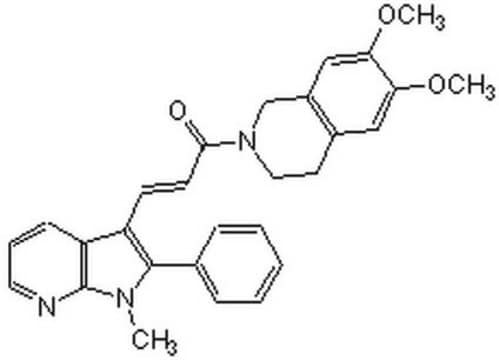SML0832
TLR4-IN-C34
≥98% (HPLC)
Synonim(y):
2-Acetamidopyranoside, C34, Isopropyl 2-(acetylamino)-2-deoxy α-D-glucopyranoside 3,4,6-triacetate
Wybierz wielkość
498,00 zł
Wybierz wielkość
About This Item
498,00 zł
Polecane produkty
Próba
≥98% (HPLC)
Formularz
powder
warunki przechowywania
desiccated
kolor
white to beige
rozpuszczalność
H2O: 1 mg/mL, clear (warmed)
temp. przechowywania
−20°C
ciąg SMILES
N([C@H]1[C@H](O[C@@H]([C@H]([C@@H]1OC(=O)C)OC(=O)C)COC(=O)C)OC(C)C)C(=O)C
InChI
1S/C17H27NO9/c1-8(2)24-17-14(18-9(3)19)16(26-12(6)22)15(25-11(5)21)13(27-17)7-23-10(4)20/h8,13-17H,7H2,1-6H3,(H,18,19)/t13-,14-,15-,16-,17+/m1/s1
Klucz InChI
KMIQMFHPUJUDMC-HHARLNAUSA-N
Opis ogólny
Zastosowanie
Działania biochem./fizjol.
Kod klasy składowania
11 - Combustible Solids
Klasa zagrożenia wodnego (WGK)
WGK 3
Temperatura zapłonu (°F)
Not applicable
Temperatura zapłonu (°C)
Not applicable
Wybierz jedną z najnowszych wersji:
Certyfikaty analizy (CoA)
Nie widzisz odpowiedniej wersji?
Jeśli potrzebujesz konkretnej wersji, możesz wyszukać konkretny certyfikat według numeru partii lub serii.
Masz już ten produkt?
Dokumenty związane z niedawno zakupionymi produktami zostały zamieszczone w Bibliotece dokumentów.
Klienci oglądali również te produkty
Produkty
Bioactive small molecules for immune system signaling target identification/validation and antibiotics, antivirals, and antifungals offered.
Active Filters
Nasz zespół naukowców ma doświadczenie we wszystkich obszarach badań, w tym w naukach przyrodniczych, materiałoznawstwie, syntezie chemicznej, chromatografii, analityce i wielu innych dziedzinach.
Skontaktuj się z zespołem ds. pomocy technicznej











